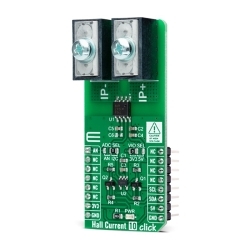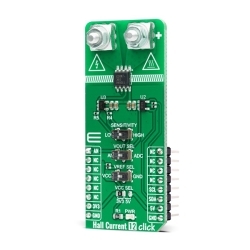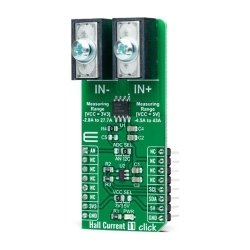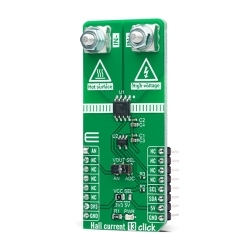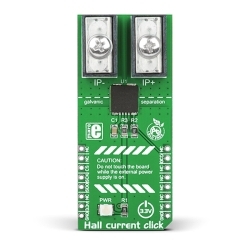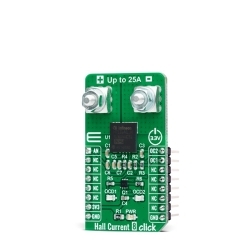MIKROE Hall Current 15 Click
Hall Current 15 Click is a compact add-on board that provides precise AC or DC current-sensing solution.
Product Overview
Hall Current 15 Click is a compact add-on board that provides precise AC or DC current-sensing solution. This board features the TMCS1101-Q1, a galvanically isolated Hall-effect current sensor capable of DC or AC current measurement with high accuracy, excellent linearity, and temperature stability from Texas Instruments. A low-drift, temperature-compensated signal chain provides <1.5% full-scale error across a broad operating temperature range. It also provides a reliable 600V lifetime working voltage and 3kVRMS isolation between the current path and circuitry with uni/bidirectional current sensing. Besides, the user is allowed to process the output signal in analog or digital form. This Click board™ is suitable for AC or DC current-sensing in industrial and commercial systems, motor and load control, power factor correction, overcurrent protection, and more.
Hall Current 15 Click is supported by a mikroSDK compliant library, which includes functions that simplify software development.
Hall Current 15 Click as its foundation uses the TMCS1101-Q1, a precise Hall-effect current sensor featuring a 600V isolation working voltage, <1.5% full-scale error across temperature, and device options providing both unidirectional and bidirectional current sensing from Texas Instruments. The input current flows through an internal 1.8mΩ conductor that generates a magnetic field measured by an integrated Hall-effect sensor and amplified by a precision signal chain. The device has a bandwidth of 80kHz and can be used for AC and DC current measurements. It is optimized for high accuracy and temperature stability, with offset and sensitivity compensated across the operating temperature range.
This Click board™ possesses two ways to communicate with the MCU. The analog output signal of the TMCS1101-Q1 can be converted to a digital value using ADC101C021, a 10-bit resolution analog-to-digital converter from Texas Instruments using a 2-wire I2C compatible interface, or can be sent directly to an analog pin of the mikroBUS™ socket labeled as AN. Selection can be performed by onboard SMD switch labeled as OUT SEL, setting it to an appropriate position marked as AN or ADC. The ADC101C021 can transfer data supporting modes up to High-Speed, alongside its alert function, which provides an interrupt routed to the ALR pin of the mikroBUS™ socket activated when analog input violates a programmable upper or lower limit value.
Also, this Click board™ should be connected in series with the load. The current is measured by two onboard terminal connectors, one terminal block for the positive and the other for the negative current input.
This Click board™ can operate with both 3.3V and 5V logic voltage levels selected via the VCC SEL jumper. This way, it is allowed for both 3.3V and 5V capable MCUs to use the communication lines properly. However, the Click board™ comes equipped with a library containing easy-to-use functions and an example code that can be used, as a reference, for further development.
Features & Specs
- Interface: Analog, I2C
- Compatibility: mikroBUS™
- Input Voltage: 3.3V or 5V
- Measurement Range @ VCC=3.3V: Min. -5.6A, Max. 55.4A
- Measurement Range @ VCC=5V: Min. -9A, Max. 86A
- Sensitivity: 50 mV/A
- Operating Temperature Range: Min. -40°C, Typ. +25°C, Max. +120°C
Documentation
Customer Reviews
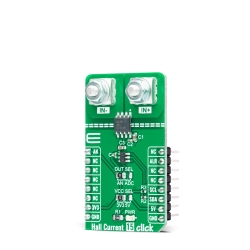
Stock and Customer Discounts
Available Discounts
- $19.90 | 25+ units
- $18.86 | 100+ units



